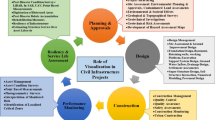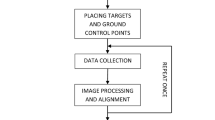Abstract
Since 2015, smart rocks with embedded magnets have proven promising to measure the maximum scour depth around a bridge pier. However, the field tests from a magnetometer installed on a truck-mounted crane moving across a bridge deck were time-consuming and caused a safety concern associated with traffic congestion. In this study, an unmanned aerial vehicle (UAV) is proposed as a mobile station for the measurement of magnetic fields of the Earth, a bridge, and a smart rock. The UAV was equipped with a three-axis, high-resolution magnetometer and a global positioning system (GPS). The magnetometer and the GPS were integrated to provide a synchronized measurement of magnetic fields and their corresponding coordinates. The effects of UAV speed, motor current and GPS accuracy on the accuracy of smart rock positioning were investigated in an open field. As an important parameter of the rock localization algorithm, the ambient magnetic field around a bridge site was numerically simulated under the Earth’s magnetic field, taking into account the distribution of steel reinforcing bars in bridge piers. The computational results are in good agreement with experimental data with less than 3.75% in error. Six field tests at the Roubidoux Creek Bridge since 24 January 2018 has demonstrated an approximately 0.3 m accuracy of the smart rock positioning. During the February 2019 flood event, the existing scour hole was deepened by 0.4 m. The proposed UAV-based smart rock positioning method was compared favorably with the previous crane-based positioning method.























Similar content being viewed by others
References:
Maddison B (2012) Scour failure of bridges. Proc Inst Civ Eng Forensic Eng 165(1):39–52
Wang H, Hsieh S, Lin C et al (2012) Forensic diagnosis on flood-induced bridge failure. I: determination of the possible causes of failure. J Perform Constr Fac 28(1):76–84
Briaud J, Chen H, Li Y et al (2005) SRICOS-EFA method for contraction scour in fine-grained soils. J Geotech Geoenviron Eng 131(10):1283–1294
Melville BW, Coleman SE (2000) Bridge scour. Water Resources Publication, Colorado
Briaud JL, Hunt BE (2006) Bridge scour & the structural engineer. Struct Mag 58–61
Rhodes J, Trent R (1993) Economics of floods, scour, and bridge failures. J Hydraul Eng 928–933
Arneson LA, Zevenbergen LW, Lagasse PF et al (2012) Evaluating scour at bridges, 5th ed. Hydraulic Engineering Circular no. 18, Publication no. FHWA-HIF-12-003. Federal Highway Administration, Washington DC, US Department of Transportation
Kamojjala S, Gattu NP, Parola AC et al (1994) Analysis of 1993 Upper Mississippi flood highway infrastructure damage. Water Res Eng 1061–1065
Lagasse PF, Clopper PE, Pagán-Ortiz JE et al (2009) Bridge scour and stream instability countermeasures: experience, selection, and design guidance, 3rd edn. Hydraulic Engineering Circular no. 23, Publication no. FHWA-NHI-09–111, Federal Highway Administration, Washington, DC. US Department of Transportation
Lu J, Hong J, Su C et al (2008) Field measurements and simulation of bridge scour depth variations during floods. J Hydraul Eng 134(6):810–821
Hunt BE (2009) Monitoring scour critical bridges. Report for Transportation Research Board. Report no. NCHRP report 396, Project no. 20-5. National Research Council, Washington, DC
Yu X, Yu X (2009) Time domain reflectometry automatic bridge scour measurement system: principles and potentials. Struct Health Monit 8(6):463–476
Xiong W, Cai CS, Kong X (2012) Instrumentation design for bridge scour monitoring using fiber Bragg grating sensors. Appl Opt 51(5):547–557
Azhari F, Loh KJ (2017) Laboratory validation of buried piezoelectric scour sensing rods. Struct Contr Health Monit 24(9):1969
Wang C, Wang H, Ho C (2012) A piezoelectric film type scour monitoring system for bridge pier. Adv Struct Eng 15(6):897–905
Ding Y, Yan T, Yao Q et al (2016) A new type of temperature-based sensor for monitoring of bridge scour. Measurement 78:245–252
Zarafshan A, Iranmanesh A, Ansari F (2011) Vibration-based method and sensor for monitoring of bridge scour. J Bridge Eng 17(6):829–838
Lin YB, Lai JS, Chang KC et al (2010) Using mems sensors in the bridge scour monitoring system. J Chin Inst Eng 33(1):25–35
Anderson NL, Ismael AM, Thitimakorn T (2007) Ground-penetrating radar: a tool for monitoring bridge scour. Environ Eng Geosci 13(1):1–10
Fisher M, Chowdhury MN, Khan AA et al (2013) An evaluation of scour measurement devices. Flow Meas Instrum 33:55–67
Schall JD, Price GR (2004) Portable scour monitoring equipment. Report for Transportation Research Board. Report no. NCHRP report 515. National Research Council, Washington, DC
Chang W, Jihn-Sung L, Teng-Yi Y et al (2014) Pier scour monitoring system by bed-level image tracking. Int J Sediment Res 29(2):269–277
Chen G, Schafer BP, Lin Z et al (2015) Maximum scour depth based on magnetic field change in smart rocks for foundation stability evaluation of bridges. Struct Health Monit 14(1):86–99
Chen Y, Tang F, Li Z et al (2018) Bridge scour monitoring using smart rocks based on magnetic field interference. Smart Mater Struct 27(8):085012
Tang F, Chen Y, Li Z et al (2019) Characterization and field validation of smart rocks for bridge scour monitoring. Struct Health Monit 5:6. https://doi.org/10.1177/1475921718824944
Tang F, Chen Y, Guo C et al (2019) Field application of magnet-based smart rock for bridge scour monitoring. J Bridge Eng 24(4):04019015
Chen G, Tang Y, Chen Y et al (2016) Smart rock technology for real-time monitoring of bridge scour and riprap effectiveness–design guidelines and visualization tools. Report for the US Department of Transportation. Report no. OASRTRS-14-H-MST. Washington, DC: US Department of Transportation
Find the magnetic declination at your location. http://www.magnetic-declination.com/USA/Rolla/2794626.html Accessed Sep 2019
Derby N, Olbert S (2010) Cylindrical magnets and ideal solenoids. Am J Phys 78(3):229–232
Boggs P, Tolle J (1989) A strategy for global convergence in a sequential quadratic programming algorithm. SIAM J Numer Anal 26(3):600–623
Acknowledgements
Financial support for this study is provided by the U.S. Department of Transportation, Office of the Assistant Secretary for Research and Technology (USDOT/OST-R) under Grant No. 69A3551747126 through INSPIRE University Transportation Center (http://inspire-utc.mst.edu) at Missouri University of Science and Technology. The views, opinions, findings and conclusions reflected in this publication are solely those of the authors and do not represent the official policy or position of the USDOT/OST-R, or any State or other entity. The authors would like to thank additional project team members for their input during field tests, including Yanping Zhu, Zepeng Chen, Cole Distler, and Dr. Gang Wang. The authors also thank Chao Liu for his assistance in three-dimensional electromagnetic analysis.
Author information
Authors and Affiliations
Corresponding author
Additional information
Publisher's Note
Springer Nature remains neutral with regard to jurisdictional claims in published maps and institutional affiliations.
Rights and permissions
About this article
Cite this article
Zhang, H., Li, Z., Chen, G. et al. UAV-based smart rock localization for bridge scour monitoring. J Civil Struct Health Monit 11, 301–313 (2021). https://doi.org/10.1007/s13349-020-00453-w
Received:
Revised:
Accepted:
Published:
Issue Date:
DOI: https://doi.org/10.1007/s13349-020-00453-w




